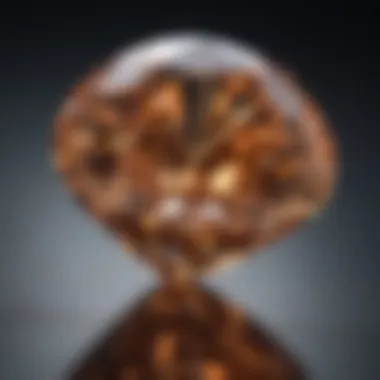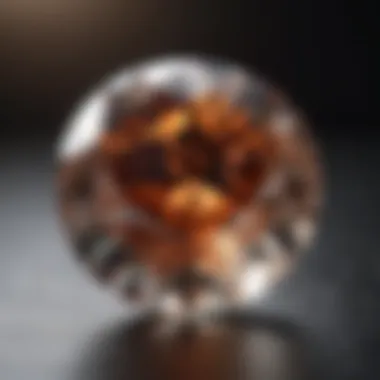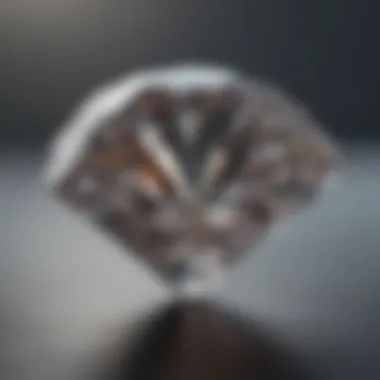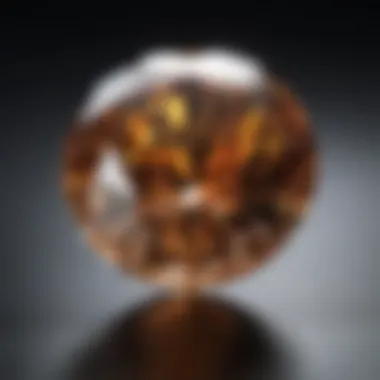Understanding the Worth of a 12 Carat Diamond


Intro
The world of diamonds is as intricate as it is fascinating. One of the most sought-after forms of beauty in this domain is the 12 carat diamond. Understanding its value goes beyond just a superficial glance. It invites an examination of various elements that collectively establish its market worth. This article aims to dissect those factors, exploring everything from carat weight to market trends. By the end of this discussion, readers will not only have a clearer picture of what influences diamond valuation but also gain insights into the specific attributes that a 12 carat diamond possesses.
Gemstone Overview
Definition of Gemstones
Gemstones are valuable minerals, often cut and polished for use in jewelry and ornaments. They are prized for their beauty, rarity, and durability. A diamond, in particular, is a form of carbon, and its unique crystalline structure contributes to its exceptional hardness. This characteristic makes diamonds the hardest naturally occurring materials, hence their desirability.
Classification of Gemstones
Gemstones are classified into two main categories: precious and semi-precious. Precious gemstones include diamonds, rubies, sapphires, and emeralds. These stones are considered more valuable due to their rarity and the quality of their characteristics. Semi-precious stones, such as amethyst and garnet, are more abundantly available yet still hold aesthetic value.
This classification is important, as it sets the stage for understanding the valuation of specific gemstones like diamonds.
Historical Significance
Origins of Gemstone Use
Gemstones have been part of human civilization for millennia. The use of stones can be traced back to ancient cultures, where they served as symbols of power and wealth. Diamonds have been particularly notable, with some evidence suggesting their use in ancient India as early as 4,000 years ago.
Cultural Insights: Gemstones in Ancient Civilizations
Throughout various cultures, gemstones served multiple roles. They were often seen as talismans, believed to hold protective properties. In ancient Egypt, for example, gemstones adorned the tombs of pharaohs, signifying their importance in the afterlife. The reverence for these precious stones has persisted into modern times, shaping the contemporary perception of gemstones.
Diamonds were once thought to possess mystical powers, influencing both luck and love.
Understanding this historical context adds depth to the conversation about diamonds today, particularly when discussing the value of a 12 carat diamond.
Closure
The exploration of gemstones, especially diamonds, entails both cultural significance and market dynamics. As we proceed in this article, further examination of specific attributes like carat weight, clarity, and current market trends will reveal why a 12 carat diamond holds its unique position in the gemstone market.
Prelims to Diamond Valuation
Diamonds have fascinated humans for centuries. Their sparkle captivates, but the true essence of a diamond lies in its valuation. Understanding how diamonds are valued is critical for both buyers and sellers. This section will lay the foundation for comprehending how various elements come into play when determining the worth of a diamond, especially one as significant as a 12 carat piece.
Overview of Diamonds as Precious Gemstones
Diamonds are classified as precious gemstones due to their rarity and unique properties. They are the hardest known substance on Earth, making them desirable not only for adornment but also for industrial applications. Each diamond tells a story, shaped by nature over millions of years, and its beauty is further enhanced through skilled craftsmanship.
Diamonds vary widely in quality, color, and overall appearance. Moreover, their symbolism of love and commitment contributes to their high market value. Understanding the characteristics that classify diamonds as precious gemstones helps buyers appreciate their intrinsic worth.
Understanding Carat Weight
The carat weight is one of the most straightforward yet crucial aspects of diamond valuation. It is a unit of measurement that refers to the weight of the diamond, with one carat equating to 200 milligrams.
Definition of Carat
Carat weight significantly impacts the diamond's market value. Essentially, the higher the carat weight, the larger the diamond. This characteristic draws more attention, especially in luxury markets. People often perceive larger diamonds as more valuable. However, this perception does not always translate into value if other quality factors are lacking.
Because of its defining characteristics, carat weight became a standard measure in the gemstone industry. Understanding this measurement allows buyers to differentiate between diamonds more effectively, ensuring informed purchasing decisions.
Impact of Carat on Price
Carat weight directly affects the price of a diamond, often leading to a non-linear price increase. Larger diamonds, like 12 carats, can be exponentially more expensive per carat than smaller ones. This is due to the increasing rarity of larger stones.
A 12 carat diamond not only demands a higher price due to its weight but also captures buyer interest due to its imposing presence. Nonetheless, a large carat weight does not guarantee high quality. The overall evaluation must integrate other factors such as cut, clarity, and color, showing that while carat plays a significant role, it is not the only aspect in determining a diamond's ultimate value.
Factors Influencing the Worth of a Carat Diamond
Understanding the factors that influence the value of a 12 carat diamond is crucial before making any investment or purchasing decision. The worth of a diamond is not solely based on its carat weight, even though this aspect plays a significant role. Other attributes such as cut, color, clarity, market dynamics, and the role of certifications also contribute to its overall valuation.


Each of these elements should be considered carefully. For instance, a poorly cut diamond may not sparkle as brightly as a well-cut one, which may affect its desirability and price. Similarly, consumer preferences and market demand fluctuate, which can additionally sway the value significantly.
The Four Cs of Diamonds
The concept of the Four Cs – Cut, Color, Clarity, and Carat Weight – serves as the primary guideline for assessing the value of diamonds. Each of these categories is interlinked but distinct enough to warrant individual consideration.
Cut
Cut refers to how well the diamond has been shaped and faceted. This characteristic greatly affects how light interacts with the stone. A well-cut diamond exhibits brilliance and fire, traits that are essential for a diamond’s overall appearance. It is beneficial to choose stones with excellent or ideal cuts, as these will display the greatest visual appeal.
The unique feature of cut is how it can amplify or diminish the color and clarity of the diamond. A superior cut can make even an average diamond appear more valuable. Poor cuts can lead to light being lost, resulting in dullness.
Color
Color classification is significant in assessing the diamond’s value. Diamonds are graded on a scale from D (colorless) to Z (light yellow). Colorless diamonds are considered the most valuable because they allow maximum light return, enhancing brilliance.
The unique aspect of this grading system is how it impacts market demand. Lower color grades may appeal more to budget-conscious consumers, but for collectors and investors, higher color grades remain a popular choice due to their rarity.
Clarity
Clarity denotes the presence of internal or external imperfections in a diamond, known as inclusions and blemishes. The fewer flaws a diamond has, the higher its clarity grade and value. High clarity diamonds (graded as VVS1 or VVS2) tend to attract collectors and luxury buyers.
A key feature of clarity is its complexity. Two diamonds might have the same carat weight yet differ greatly in clarity. For investment purposes, clarity becomes critical as it can greatly influence potential resale price.
Carat Weight
Carat weight is a straightforward measure of a diamond’s weight. As weight increases, so does the potential value. A 12 carat diamond is not only rare but also highly sought-after. Nonetheless, carat weight alone does not determine worth.
A unique feature of carat weight is how it combines with the other Cs. For example, a well-cut, high-clarity diamond weighing 12 carats can be exorbitantly more valuable than a larger one with poor cut and clarity. Buyers need to consider the cumulative effect of all four attributes in their assessment.
Market Dynamics and Demand
Market dynamics play a vital role in establishing diamond prices. Elements such as consumer preferences and supply chain factors create varying demand for particular diamond types.
Consumer Preferences
Consumer preferences are constantly evolving. Recent trends indicate a growing interest in ethical and sustainable sourcing for diamonds. Buyers now often prefer stones that come from responsible sources.
This changing preference can add value to specific diamonds, especially for those perceived as socially responsible. The unique aspect of consumer demand is the trend's volatility; a diamond highly sought today may lose significant appeal in the near future.
Supply Chain Factors
Supply chain factors also significantly influence diamond pricing. The production process, transportation, and retail availability affect how diamonds are valued at different marketplaces. Variability in supply directly relates to market prices.
The unique challenge lies in the stability of this supply. Disruptions in producing countries can lead to price spikes, impacting valuation significantly.
The Role of Certifications
Certifications provide essential documentation that outlines the quality aspects of a diamond. They add credibility and can influence a buyer's perception of the diamond’s worth.
Importance of Grading
Grading diamonds according to recognized standards helps consumers make informed choices. This grading process ensures that buyers can trust their purchase, knowing it has been examined by experts.
A primary advantage of grading is the objectivity it provides. Buyers have reliable references when comparing diamonds, enhancing confidence in their purchase decisions.
Recognized Grading Institutions
Well-known institutions like the Gemological Institute of America (GIA) or the American Gem Society (AGS) carry credibility. Diamonds certified by these organizations are generally held in higher esteem and valued appropriately.
The unique aspect of recognized institutions is their global recognition and influence on market pricing. Diamonds with credible certifications tend to fare better in auctions and retail settings, sometimes commanding higher prices.
Estimating the Worth of a Carat Diamond


Estimating the worth of a 12 carat diamond is crucial for anyone involved in the buying or selling of diamonds. This process allows potential buyers to understand what they are paying for, while sellers can set a fair market price. Knowing how to determine value affects not just individual transactions but also the broader market dynamics.
Several factors influence the pricing and worth of diamonds. These are not merely random; they stem from established metrics in the diamond trade. Hence, grasping these elements is fundamental to making informed decisions regarding diamond investments or purchases.
Calculating Price per Carat
Price Ranges for Different Qualities
The pricing of diamonds is not uniform; it varies substantially with quality. The price per carat for a 12 carat diamond can range anywhere from a few thousand to significant figures surpassing one hundred thousand dollars. Price is heavily impacted by the diamond's characteristics, particularly the four Cs: cut, clarity, color, and carat weight. A well-cut diamond, for example, might command a premium even among similar quality stones due merely to its cut and brilliance.
Key characteristics can often correlate with perceived value. For instance, diamonds that exhibit exceptional color and clarity can see pricing multiply as carat weight increases. The unique feature of this pricing framework is that it allows both buyers and sellers to gauge worth with relative clarity, although the price can be subjective based on market conditions.
Factors Affecting Price Fluctuations
Price fluctuations in diamonds often occur due to various market conditions. Economic factors, changes in consumer preference, or even geopolitical issues can impact the demand for diamonds, and subsequently, their price. For instance, during economic downturns, luxury goods, including high-carat diamonds, can face a decline in demand, which may reduce their worth.
Key characteristics that affect these fluctuations include the brand reputation of a diamond dealer, as well as the diamond’s unique qualities such as unique inclusions or historical significance. A major advantage in understanding these fluctuations is the preparedness it brings to those involved in diamond transactions.
Comparative Analysis with Other Carat Sizes
Value Trends Across Carat Weights
When analyzing the worth of a 12 carat diamond, comparing it with smaller carat diamonds is essential. The value per carat tends to increase as carat weight rises. This means that while a five carat diamond may be priced at a certain level, a ten carat diamond retains a higher value per carat.
Key characteristics to note include how mainstream preferences shift between size and quality. A twelve carat diamond may attract collectors specifically looking for larger stones, enhancing its demand and thus its worth. Understanding these trends can assist potential investors and buyers in making educated decisions.
Investability of Larger Diamonds
Larger diamonds, including a 12 carat diamond, often come with unique investability traits. They can serve as an effective hedge against inflation and may appreciate over time, especially if they possess the right mix of quality.
Key aspects include the limited availability of such large stones in the market, which may contribute to an escalation in value over time. However, it is critical to note the potential downsides. Not all larger diamonds appreciate equally, and maintaining them can sometimes lead to extra costs.
"Understanding the intricate details about pricing and market trends can empower buyers and sellers alike."
Through this detailed examination, it becomes evident that evaluating a 12 carat diamond entails a multitude of considerations. Each characteristic, from price ranges based on quality to trends across various carat sizes, weaves into an overarching narrative that shapes the complete understanding of value in this segment of the gemstone market.
The Market for Carat Diamonds
The market for 12 carat diamonds represents a distinct segment within the broader diamond trading landscape. Understanding this market is vital for potential buyers and investors. As diamonds increase in carat weight, their rarity escalates, significantly impacting their market value. A 12 carat diamond is not just a larger stone; it embodies a multitude of facets that influence pricing and desirability.
In this section, we examine current market trends and perspectives from auction and retail environments. Understanding these elements is essential to navigate the intricate world of diamond investment and potential appreciation.
Current Market Trends
Emerging Consumer Demographics
Emerging consumer demographics play a crucial role in reshaping the diamond market. Younger buyers, particularly millennials and Gen Z, have varying preferences compared to traditional luxury markets. They tend to value authenticity, sustainability, and unique experiences over historic notions of luxury.
This shift highlights the importance of understanding the new consumer landscape. Diamonds are no longer purely status symbols; they have become personal statements. As these consumers seek more personalized jewelry options, the demand for larger stones like a 12 carat diamond is influenced by their preference for distinctiveness and emotional connection.
Some advantages of this shift include the broader appreciation for diamonds as symbols of individuality. However, younger consumers can also be more price-sensitive, prompting new pricing strategies within the industry.
Sustainability and Ethically Sourced Diamonds
Sustainability has become a prominent factor in today's diamond market. Consumers increasingly prefer diamonds that are ethically sourced and conflict-free. This demand is driving retailers to provide transparency about their sourcing practices.
When discussing sustainability, it becomes clear that diamonds which uphold ethical standards are gaining precedence. This characteristic appeals to many consumers, making it a beneficial option for the market. Ethical considerations not only enhance the diamond's image but also create a narrative that resonates with conscious consumers.
However, the unique feature of this demand is the potential for higher pricing on ethically sourced diamonds. While ethical diamonds can command a premium, the question remains whether all consumers are willing to pay extra. The balance between ethical considerations and price demands a careful look at the changing tides of consumer preferences.
Auction and Retail Perspectives
Understanding the performance of 12 carat diamonds at auctions and in retail stores offers critical insights into their market dynamics. This perspective helps in grasping how these large gemstones are valued differently across platforms.


Performance at Auctions
The auction market provides a unique venue for high-value diamond transactions. Performance at auctions can significantly differ from retail sales, offering insights into market appetite for such exclusive gems. A 12 carat diamond's auction performance often reflects not just its intrinsic value but also market demand, rarity, and unique characteristics.
The key characteristic of auction sales is their capacity to attract high-net-worth buyers. Auctions can push prices beyond traditional market expectations, as buyers compete for unique pieces. This aspect of auctions invites both risks and rewards for investors. Success at auction can signal robust interest, but market volatility can also lead to unpredictable outcomes.
Comparative Retail Prices
Comparative retail prices for diamonds can provide a benchmark for understanding value. The different pricing strategies employed across retailers demonstrate how market demand fluctuates between locations and platforms.
One key aspect of retail is the transparency of pricing compared to auctions. Retail prices generally offer more consistency, making it easier for buyers to gauge value. This aspect is beneficial for casual buyers who may not engage with auction processes.
However, the disadvantage arises from potential markups related to store overhead costs and branding. Retail prices may not always represent the diamond's true market value, which could be significantly higher in an auction setting. Therefore, discerning consumer awareness is necessary when navigating this landscape.
Understanding these market dynamics not only equips buyers but also investors with knowledge. This enhances their decision-making process surrounding 12 carat diamonds. As market conditions evolve, careful monitoring of trends will remain essential for anyone involved in the diamond sector.
Investment Considerations
Understanding the investment considerations related to diamonds, specifically a 12 carat diamond, is paramount for both novice and seasoned investors. The diamond market poses unique opportunities and challenges. These considerations can affect the decisions one makes, whether to buy, hold, or sell a diamond. Key elements include the liquidity of the market and the long-term appreciation potential. Each contributes to a holistic understanding of how diamonds function as investment assets.
Diamonds as an Investment Vehicle
Market Liquidity
Market liquidity refers to the ease with which an asset can be bought or sold in the market without causing a significant change in its price. In the diamond trade, liquidity can vary significantly based on several factors. One key characteristic of diamond liquidity is the demand trends in the luxury market. When consumer interest is high, diamonds can typically be sold more easily.
A unique feature of diamond liquidity is its relative dependency on market perception and branding. Well-known diamonds, especially those with good certifications, tend to maintain better liquidity than lesser-known counterparts. The advantage here is clear: a diamond that has a strong pedigree will attract more potential buyers, facilitating quicker sales. One of the potential disadvantages lies in the lack of standardized pricing, which can make it hard to gauge liquidity accurately.
Long-term Appreciation Potential
Long-term appreciation potential is an essential factor for investors considering diamonds as viable investment options. This characteristic reflects the capacity of diamonds to increase in value over time, influenced by rarity and demand dynamics. The unique feature of this potential lies in the fact that certain diamonds, especially those that are larger and of higher quality, often increase more significantly in value compared to smaller stones.
Investors often see this as a beneficial aspect of diamonds. Having ownership of a 12 carat diamond can be seen as holding an asset that appreciates well over time, contrasting against more volatile investment options. However, potential investors must be cautious, as this appreciation is not guaranteed. Market shifts and changes in consumer preferences can introduce risks that impact the long-term outlook of diamond valuations.
Risks Involved in Diamond Investment
Price Volatility
Price volatility is a critical aspect of diamond investments that investors should be fully aware of. It refers to the fluctuations in prices that diamonds may experience due to various market forces. This characteristic of price volatility indicates that while a diamond may appreciate, it can also face downward pressure in certain economic conditions.
A unique feature of price volatility in the context of diamonds is its dependence on luxury market trends. Economic downturns can severely impact the demand for luxury items, including diamonds. This can lead to dramatic decreases in price. Therefore, investors need to maintain a watchful eye on economic indicators when considering entering the market or holding onto their investment.
Market Dependence
Market dependence describes the reliance of diamond values on broader market conditions. This characteristic signifies that the worth of a diamond can be influenced by external factors, such as economic health and changes in consumer sentiment toward luxury goods.
The unique feature of market dependence lies in its connection to niche market trends. Investor behavior can change dramatically based on fashion, celebrity endorsements, or emerging global trends. While this can create opportunities, it introduces a level of risk. For investors, understanding these nuances is essential to mitigating losses or optimizing potential returns.
In summary, investing in diamonds involves careful consideration of liquidity, appreciation potential, price volatility, and market dependence. Each of these areas is interconnected, and understanding them is crucial for navigating the diamond investment landscape.
Finale
Additionally, market dynamics play an essential role in influencing prices. Factors such as consumer preferences and the supply chain impact the availability and demand for 12 carat diamonds. It is also vital to consider the importance of certification. Having a diamond graded by recognized institutions can significantly affect its perceived value in the market.
"The intrinsic worth of a diamond is a blend of both measurable characteristics and buyer sentiments."
As the market evolves, new trends emerge that alter how diamonds are viewed as assets. For those looking to invest, understanding the potential risks alongside the long-term appreciation of diamonds is key.
By synthesizing these insights, individuals can make informed decisions when purchasing or investing in a 12 carat diamond. Awareness of these elements encourages smarter choices, ensuring better outcomes in both personal and financial matters.
Summary of Key Points
- The Four Cs determine the quality and value of a diamond.
- Market dynamics, driven by supply and demand, affect prices and desirability.
- Certification from recognized grading institutions-assures buyers of quality.
- Investment considerations include the potential for appreciation and risks of market volatility.
Future Outlook for Diamond Valuation
The future of diamond valuation looks poised for transformation. With shifting consumer preferences leaning towards ethically sourced and sustainable diamonds, traditional valuation models may evolve. The increased focus on environmental impacts will likely shape production practices and demand patterns.
As technology advances, the enhancement of grading tools may provide even more precise evaluations of diamonds, helping to standardize how value is assigned. Additionally, the rise of online marketplaces could democratize access to diamond investment, leading to a broader consumer base interested in large diamonds like the 12 carat.
Investors might also find new opportunities as the market evolves, with trends indicating a move towards valuing unique designs or historical significance alongside traditional characteristics. As such, those contemplating investment should remain vigilant and adaptive to these changes.



